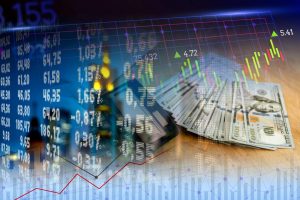Key Insights:
- Q4 reflected that the TRON network ushered in new users and network activity. Daily active accounts continued a steady climb, daily activated (new) accounts reversed course, and the network saw an unusual spike to 1.3 million new accounts on December 10.
- Smart contract execution and TRX transfers accounted for 90% of total transactions over the quarter.
- Due to increased user activity, a substantial amount of TRX was burned versus generated during Q4.
- TRON’s place in the stablecoin landscape remained substantial in terms of its market cap of stablecoins, second to Ethereum.
- TRON client GreatVoyage-V4.6.0 (Socrates) was released to improve network functionality.
- The TRON DAO Ecosystem Fund will aim to expand the use of USDD, diversify DeFi, and expand the TRON ecosystem into other sectors with the support of TRON DAO Ventures.
Primer on TRON
TRON is a public open-sourced blockchain network using a Delegated-Proof-of-Stake (DPoS) mechanism and the Practical Byzantine Fault Tolerance (PBFT) consensus algorithm. DPoS is an election mechanism that determines who maintains the network. An election occurs every six hours, resulting in 27 Super Representatives who take turns producing blocks.
The TRON Virtual Machine (TVM) powers applications on the network and uses “Energy & Bandwidth” instead of gas, like its Ethereum Virtual Machine (EVM) counterpart. The TVM is EVM-compatible and effectively offers developers more affordable smart contract execution.
Key Metrics

The Fourth Quarter Narrative
It was a rollercoaster of a year for the crypto industry. Macroeconomic forces sparked a bear market in January. The bear was perpetuated by the collapse of LUNA and UST in the spring. Finally, the failure of FTX and the contagion that followed brought significant headwinds to the market. Despite the FTX drama and unfavorable price action, Q4 reflected that the TRON network ushered in new users and network activity. Efforts to grow its ecosystem also continued.
As the year ended, TRON’s strength in the stablecoin space remained intact. Its position in the space strengthened as the TRON community celebrated the Commonwealth of Dominica’s decision to declare TRON as the official protocol for its national blockchain infrastructure. The island country also confirmed the statutory status of TRON native assets, including USDT and USDD.
Not only did TRON maintain its place in the stablecoin space, but it also took several steps forward in other areas. Several network upgrades were released to improve functionality, integrations improved user access and experience, and an investment strategy was deployed beyond stablecoin adoption and to DeFi, NFTs, GameFi, and beyond. Community-building efforts were also prevalent, with the Grand Hackathon Season 3 and TRON joining the Enterprise Ethereum Alliance.
As a follow-up to the State of TRON Q3 2022 report, this report will dive into the quantitative performance over 2022 and Q4 and the qualitative evidence that TRON is continuing to progress through adverse market conditions and pursue catalysts for growth.
*Subsequent events will be covered in the State of TRON Q1 2023 report.
Performance Analysis
Network and Financial Overview

User activity, measured by daily active accounts, activated new accounts, and transactions, was up across the board QoQ. The activity differed significantly from Q3, with each metric growing by double-digit percentage points.
Despite the network experiencing an influx of user activity, transaction fees, on average, were flat QoQ.

While average transaction fees were flat QoQ, total revenue increased by 25% due to the high volume of user activity during the quarter.
Despite all of the activity and revenue generation and the resulting burn of TRX (TRON burns all transaction fees/revenue), market cap (i.e., network value) declined 11%. The decline in network value was likely due to the market headwinds caused by FTX’s collapse.
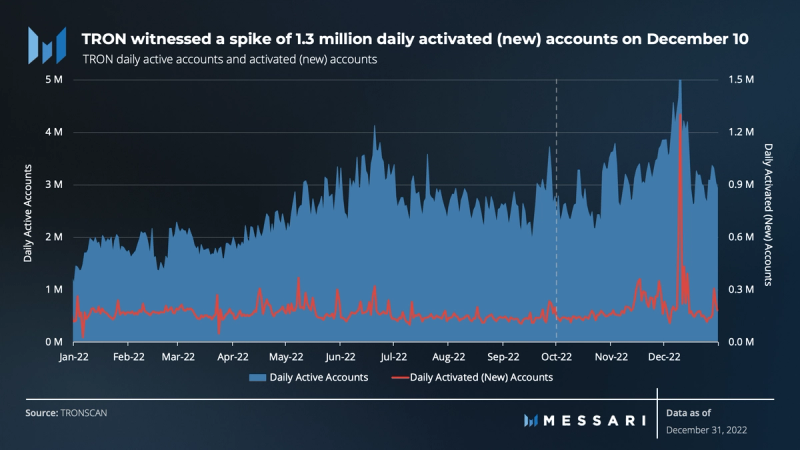
Daily active accounts were on a steady climb heading into Q4. They continued through the end of the year, growing 17.9% QoQ and finishing the year up 90.7%.
On the other hand, daily activated (new) accounts were relatively flat to down heading into Q4. The trend noticeably began reversing course at the onset of the FTX debacle in early November. Later, on December 10, 1.3 million new accounts were activated, doubling the 637,000 new accounts the day prior. Furthermore, 5.5 million accounts were active compared to the 4.6 million the day prior, representing a 20% increase over the same period. The spike in new accounts helped drive a 43.8% increase QoQ. The increase in Q4 largely accounts for the 34.4% growth in new accounts YoY as well.

On the TRON network, transactions represent all types of interactions, including token transfers, staking activity, smart contract execution, and voting activity.
Overall, average daily transactions grew by 22.4% to 6.5 million over Q4. For perspective, the average daily transaction count in Q4 2021 was 2.8 million. This 130% increase YoY can mostly be attributed to TRX transfers. Average daily TRX transfers grew by ~300% YoY. That said, the anomalous activity in December contributed to that growth as well.
Smart contract triggers were also up ~45% QoQ, indicating an increase in application usage. Transaction activity was flat for most of TRON’s DeFi protocols. However, the USD Tether (USDT) smart contract remained a primary use case and was the driver of contract execution on TRON in Q4.
The composition of transaction activity on the network may shed some light on the anomalous account activity during Q4.

The spike in account activity highlighted earlier can be tied to USDT contract calls and TRX transfers. On December 10, there were 10 million USDT contract calls and TRX transfers combined, up 28% compared to the previous day. The spike contributed to the 52% QoQ increase in USDT contract calls and the 22% QoQ increase in TRX transfers.
It’s difficult to pinpoint the exact catalyst causing many existing and new accounts to interact with USDT and to transfer TRX. Interestingly, as illustrated later in the Competitive Analysis section of this report, other networks like Ethereum also saw an uptick in activity on December 10, though not nearly as abrupt. There were plenty of notable events during that time that may have contributed to TRON’s higher spike. Although FTX’s implosion on November 8 may have been the spark, TRON’s metrics did not spike until December 10.
During the FTX meltdown, TRON DAO quickly came to an agreement with FTX on a recovery deal on November 10. The response in account metrics may have been delayed as users realized FTX was insolvent and dormant users became more active in December, moving assets on TRON and seeking refuge in USDT.
On December 4, committee proposal No. 79 was approved. The results of the proposal changed network parameters and increased the amount of Energy required to execute smart contracts. The proposal suggests that the network should disincentivize the smart contract transactions that are of lower value to the network than others. They are disincentivized by making them more expensive to deploy. The effects of raising the required amount of Energy for smart contracts are described in more detail below.
The proposal also increased the TRX staking rate and burning volume. The increase in burn led to a deflation rate of 3.17%, which is relatively higher than historical rates.
Finally, on December 6, Tether announced its launch of the Offshore Chinese Yuan (CNHT) on TRON. This too may have sparked user activity.
Ultimately, it is difficult to say how much the FTX situation contributed to the spike a month after it imploded, especially after factoring in the other noteworthy events. The approval of proposal No. 79 and the launch of CNHT may have generated additional activity, but even then, it is difficult to assume they would cause such an unusual shift. In the end, the combination of these events may have led to the notable anomaly in December.
Energy and the Resource Model
Raising the amount of Energy required for smart contract execution goes beyond rooting out low-value smart contracts. The TRON network utilizes what it calls a Resource Model. The model’s concepts and implications were detailed in the State of TRON Q3 2022 report.
To summarize, the Resource Model is based on distributing Bandwidth and Energy to stakers. As long as stakers have acquired enough resources, they can then use those resources to transfer tokens and execute smart contracts for free. Users must cover transaction fees if they utilize more computing power than their resources.
More specifically, Energy can be acquired by staking TRX. It represents the amount of CPU resources consumed during smart contract execution. When a user consumes more Energy than owned, they are charged a transaction fee in TRX, which is then burned.
Unlike Energy, Bandwidth Points are distributed free to all activated accounts every 24 hours, but like Energy, they can also be earned by staking TRX. Bandwidth allows users to perform transfers on the TRON network without paying transaction fees. This mechanism subsidizes a portion of transaction fees to keep them low. However, if users do not have sufficient Bandwidth, a transaction fee of 0.001 TRX per Bandwidth is applied and burned.
More Energy required for transactions likely leads to less Energy available (especially with all of the USDT interactions). When the demand for Energy outweighs what is available for smart contract execution, more TRX is burned.
In addition to the Energy mechanism for smart contract execution, newly activated accounts combined with the Resource Model are critical to the value accrual of TRX. To activate an account, users must transfer any amount of TRX or TRC-10 tokens or pay an account creation fee of 1 TRX.
With the increased requirements for Energy, a surge in USDT contract execution, and all of the new account activations, a substantial amount of TRX transaction fees were generated and then burned.

Indeed, a substantial amount of TRX was burned vs. generated during Q4 2022. TRON burned ~332 million out of its ~92 billion in total supply (~0.36% supply burned) in December. For perspective, TRON burned ~240 million TRX in October. The amount burned in December represented a 38% increase since the end of October. As such, TRX continues to be deflationary.
Since TRON burns 100% of its transaction fees from the network’s circulating supply, it increases scarcity. This creates value for all tokenholders rather than compounding the balances of validators and delegators. Since the burned transaction fees represent revenue, growth or declines in revenue generation influence TRX’s market value either upwards or downwards.

The activity in Q4, paired with the Resource Model, translated to a significant increase (25.3%) in revenue over the quarter. Interestingly, however, the correlation between network value and revenue broke down in December.
From a valuation perspective, the lack of correlation resulted in TRX becoming less expensive per unit of revenue compared to prior periods. For perspective, TRON’s circulating market cap was 48 times the annualized revenue at the end of Q1 2022. By the end of Q4, it was 23 times, representing a 52% decrease and a move to a more favorable valuation.
With that in mind, fundamentals like network upgrades, active users, and transaction activity will impact value accrual. The natural follow-up question asks what the TRON network is developing to drive fundamental activity. This question can be answered by evaluating TRON’s ecosystem, developer engagement, and growth strategy.
Ecosystem and Development Overview

DeFi
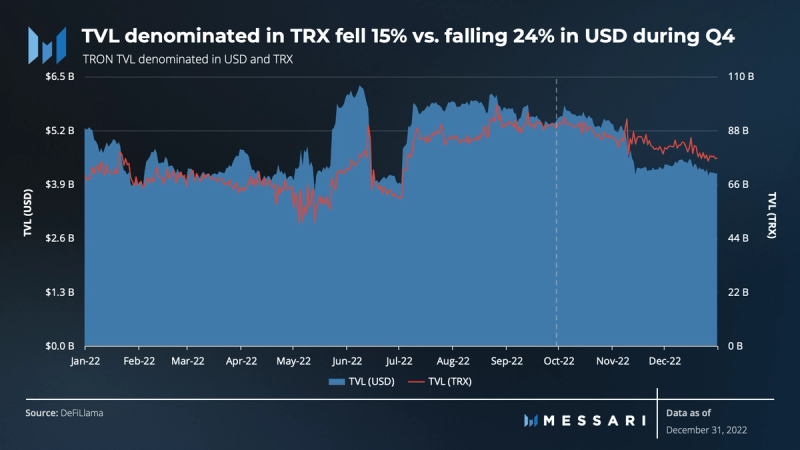
There is no doubt that early 2022 was the end of the last bull cycle and that a bear market was underway. The collapse of LUNA and FTX exacerbated the bear through the end of the year. As market sentiment shifted, TRON’s TVL fell 23.7% in USD over Q4 and finished the year down 20.6%. Notably, TVL was supported by an uptick in December, which coincides with the network behavior described earlier. Although TVL in USD was down, TVL denominated in TRX was up 9.8% YoY. From this perspective, TVL stated in USD is merely the result of the decline in TRX price and not so much the utilization of cryptoassets in TRON DeFi.
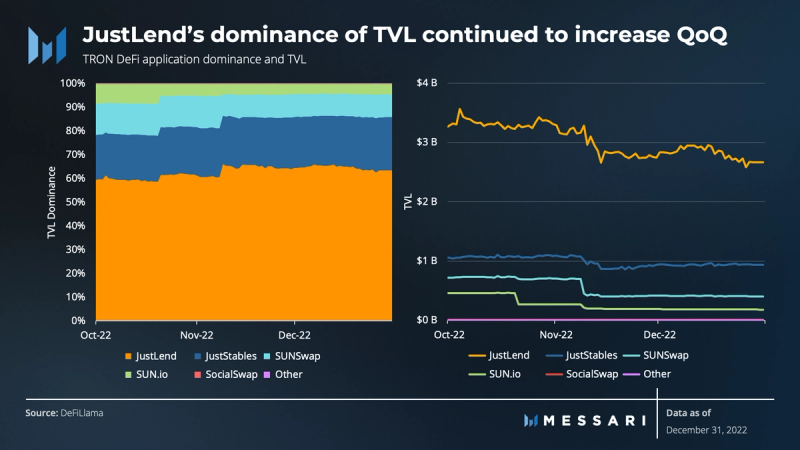
None of the DeFi applications on TRON were immune to the overall economic climate of 2022 or the FTX fallout in Q4. TRON’s most prominent protocol, JustLend, was down 18% QoQ in TVL. TRON’s other DeFi protocols, like SunSwap and JustStables, continued a downtrend during the quarter, consistent with the broader market.
JustLend’s TVL dominance grew for the second consecutive quarter. In the first half of Q3, TRON’s TVL ballooned, resulting from assets getting deposited into JustLend. The increase was primarily driven by three unique wallets (wallet 1, wallet 2, and wallet 3) depositing approximately $1.6 billion in various assets. In Q4, TVL migrated to JustLend at the onset of the FTX situation.
The shift in dominance could be seen as a risk to TRON. TRON’s TVL is heavily concentrated in JustLend, which holds roughly 64% of TRON’s DeFi TVL. If the application were to collapse due to an exploit or technical breakdown, it could significantly hamper the TRON ecosystem.
Stablecoin Landscape
While the DeFi landscape is concentrated in a small number of applications primarily used by a few large wallets, TRON’s place in the stablecoin landscape is substantial. Second only to Ethereum, TRON is far ahead of other chains in terms of the market cap of stablecoins it hosts, with over $33 billion at the end of Q4.
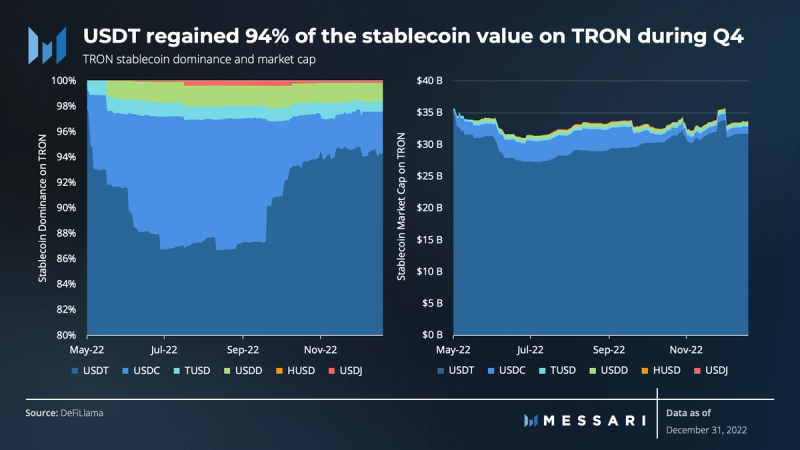
By the end of Q4, USDT regained 94% of the stablecoin value on TRON, which correlates with all of the USDT contract activity on-chain. The amount of USDT on the network could be a concentration risk to the ecosystem should USDT experience any technical or regulatory challenges. Ultimately, USDT remained the flagship stablecoin through Q4 and regained dominance as FTX unfolded in November.
USDD
TRON launched its overcollateralized hybrid-model stablecoin, USDD, in Q2. USDD is overcollateralized by a basket of stablecoins, BTC, and TRX and is pegged 1:1 against the U.S. dollar. Users can swap between other stablecoins at a 1:1 ratio without any slippage using the Peg Stability Module (PSM).
If USDD expands across the ecosystem and into others, deflation of TRX could ramp up. The combination of the Resource Model and demand for USDD could put upward pressure on revenue (TRX burn) from resource depletion. USDD could also put downward pressure on the circulating supply of TRX if it burns TRX to mint USDD to maintain its peg.
Highlights of the State of USDD through Q4 are as follows:
- The FTX collapse and market volatility led the TRON DAO to move reserves, leaving USDD undercollateralized based on the value in stablecoins and BTC in its reserves. Including TRX deposits, the stablecoin was sufficiently overcollateralized.
- Supply of USDD remained unchanged for the quarter.
- Volumes increased 27% in Q4, and the number of wallets holding USDD increased by 8%.
- USDD traded slightly below its peg through the end of the year, but no TRX was minted to restore its peg.
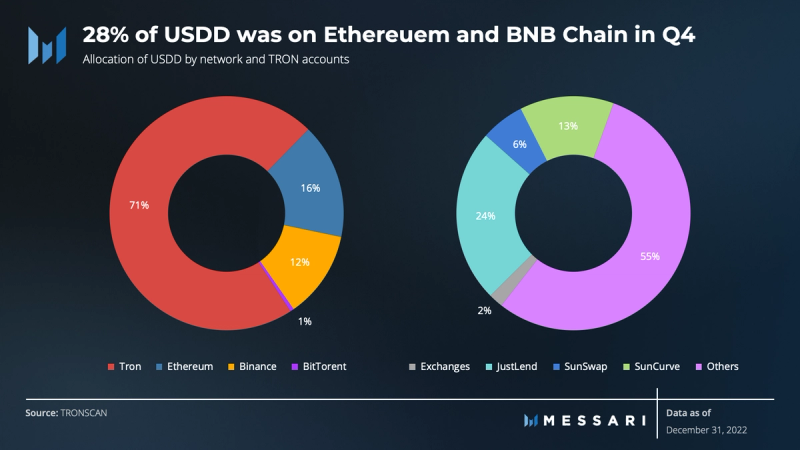
By the end of Q4, about 28% of USDD found its way to the Ethereum network and BNB Chain. Further, roughly 75% of USDD on TRON was held in smart contract accounts. The remaining 25% was in general accounts (user wallets).

The general accounts (holders) of USDD experienced minimal growth in Q4. The number of wallets on TRON holding USDD increased to over 130,000, while the average size of the holdings fell substantially since its launch in May. Nonetheless, there are ongoing efforts to expand the use of the recent USDD.
Other Stablecoin Developments
One of the developments celebrated by the TRON community during Q4 was the Commonwealth of Dominica declaring TRON as the official protocol for its national blockchain infrastructure. The island country granted TRON’s native digital tokens like TRX, USDT, and USDD “statutory status.” This status authorizes Dominicans to use TRON assets as a medium of exchange in the country.
In addition, the country used the network to launch Dominica Coin (DMC), a fan token that promotes the nation’s natural and cultural heritage. DMC subsequently launched on the Huobi exchange.
While Dominica has a small population, the statutory status is symbolic. It could lead other nation-states to follow suit, driving the use of new and existing stablecoins on TRON.
Other notable developments in the TRON stablecoin space included:
- Binance Exchange – Completed integration to enable deposits and withdrawals of BUSD on the TRON network.
- Binance.US – Completed integration to enable deposits and withdrawals of USDC on the TRON network.
- Kraken Exchange – Completed integration to enable deposits and withdrawals of USDC on the TRON network.
- Tether – Launched Offshore Chinese Yuan (CNHT) on the TRON network.
- TrueUSD – Launched Offshore Chinese Yuan (TCNH) on the TRON network.
- Guardarian – A noncustodial fiat on-/off-ramp launched support for TRON-based USDT, TUSD, USDC, and TRX.
- Travala – A growing travel application launched support for accepting USDD.
NFTs, GameFi, and Beyond
With stablecoins dominating the TRON ecosystem and the concentration of TVL in JustLend, activity from other sectors, including NFTs, GameFi, and Web3, has had to play catch up.
To that end, TRON DAO continues implementing strategies to grow and diversify TVL across DeFi and beyond. Initiatives such as the TRON Grand Hackathon seasons and the TRON DAO Grants Program aim to support communities, developers, and influencers building on the TRON network.
During Q4, the Grand Hackathon Season 3 was hosted by TRON DAO and over 40 notable partners and judges, including Van Eck, Valkyrie Investments, and Circle. The season concluded with dozens of teams receiving financial support for further development.
Notable first-place winners across several contests and tracks included:
DeFi
- Meson – Cross-chain protocol that facilitates stablecoin swaps across major public chains.
- USTX Project – TRX yield-generating application that gives weekly rewards in USTX tokens.
NFTs
- Lazara – Aims to generate NFTs with AI models.
- FuzzyOcean – Building a multichain NFT platform.
GameFi
- GalaxyThrone – Decentralized SciFi strategy game.
- TuruVerse – A gamified metaverse of shops and event spaces.
Web3
- OpenATM – A free and open-source Do-It-Yourself ATM.
- TronHub – A suite of TRON utilities aimed at simplifying the onboarding process for new users.
The TRON Grand Hackathon also offered an ecosystem track that hosted Ethereum developers. The ecosystem track focused on attracting Ethereum projects looking to expand into the TRON ecosystem.
Finally, an academy track was introduced and involved face-to-face competitions called the “Hacker House.” The Hacker House component of Season 3 was held at various campuses, including Harvard University, Dartmouth, and several other prestigious universities.
While TRON is largely used as a platform for stablecoins, TRON ultimately strives to attract developers and expand the ecosystem into other sectors.
Staking and Decentralization Overview

As mentioned, the Resource Model is based on distributing Bandwidth and Energy to stakers. The stakers can then use those resources to transfer tokens and execute smart contracts for free so long as they have acquired enough resources. If they have fewer resources than the amount of computer power utilized, users must cover transaction fees.
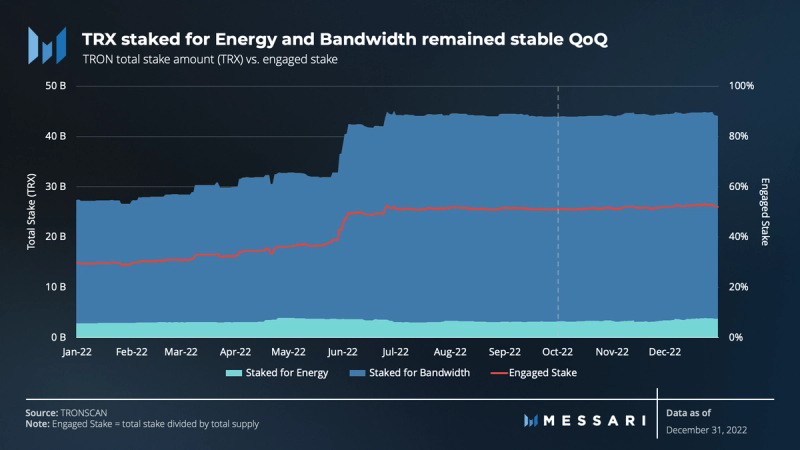
The total amounts of stake and engaged stake (total stake divided by total supply) increased dramatically after the launch of USDD in May. Since then, the amount staked for Energy and Bandwidth remained stable. With the rise in the cost of Energy in December, the amount of stake for Energy may increase going forward.
Nonetheless, a higher engaged stake represents locked assets and contributes to the stability of network value. The more staked and stable the engaged stake, the more stability can be found in TRX and the value of the network.
In addition to obtaining Bandwidth or Energy, users that stake TRX also get voting rights.
TRON employs a unique consensus mechanism compared to other base layers. The concepts and mechanisms behind the consensus are relatively complex and detailed in the Q3 2022 report.
In summary, TRON utilizes a Delegated-Proof-of-Stake (DPoS) mechanism to aid in consensus and validating blocks. Block validation is performed by a group of validators called Super Representatives (SRs). SRs are elected from a larger pool of SR candidates. The top 27 most-voted candidates become the SRs for the next epoch.
Further, all SRs and SR candidates have the right to make proposals to modify parameters on the TRON network (such as increasing the cost of Energy with proposal No. 79).
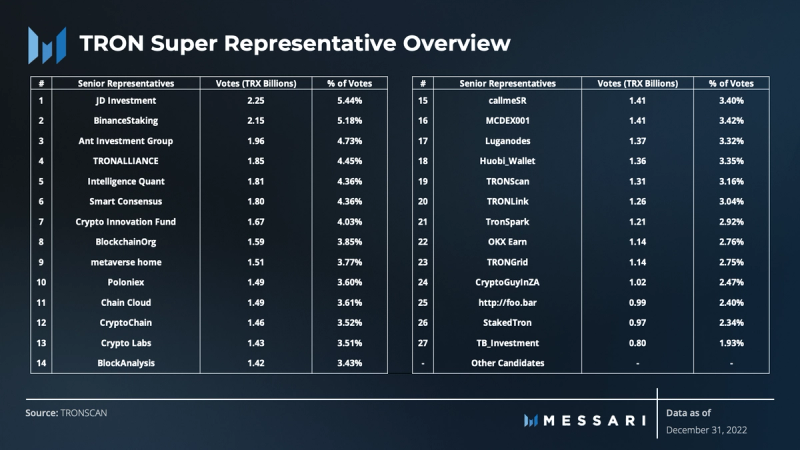
At the end of Q4, over 380 SR candidates (up from ~350 in Q3) voted for 27 SRs in each six-hour epoch. The December 31 snapshot of the top 27 SRs and their respective vote power reveals that the above 27 SRs are commonly elected to participate in block production.
There may be concerns about these 27 SRs consistently participating in securing the network. However, the growing number of SR candidates should challenge the voting population to distribute votes to a broader range of candidates.
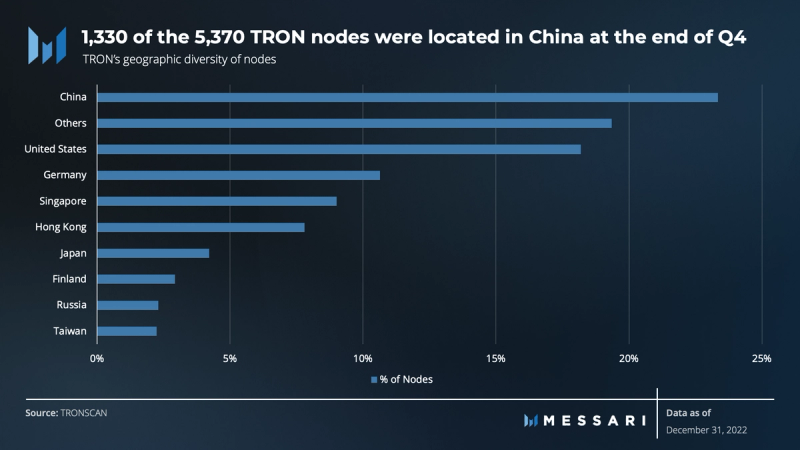
Although a democratic voting system for block production and a growing set of SR candidates may be beneficial, they don’t guarantee freedom from centralization risks. Metrics such as the geographic diversity of nodes may also ensure a more comprehensive network health.
The geographical concentration issue is typical for Layer-1 networks. Too many nodes in the same location could jeopardize the health of a network due to geopolitical risks, regulations, and acts of nature, among other reasons.
As of December 31, TRON nodes were distributed across more than 30 geographic locations around the globe.
While distributed globally, ~23% (1,330 of the 5,730 TRON nodes) were located in China. The “other” locations comprise ~20% of total nodes and include 21 different countries.
Competitive Analysis
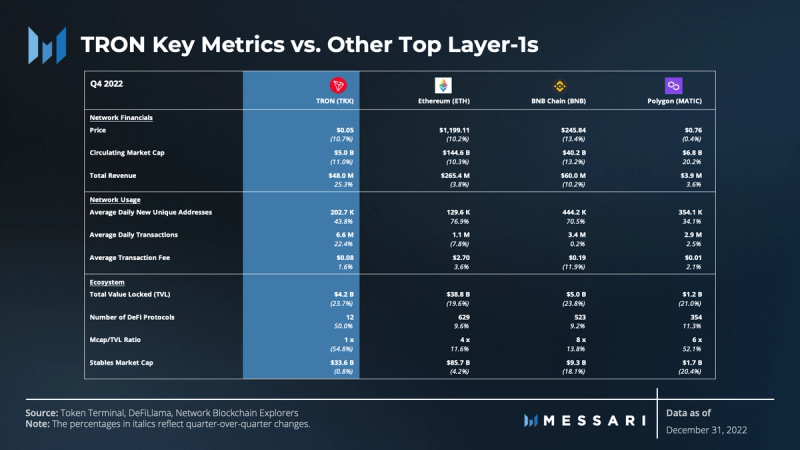
Throughout Q4, TRON’s key metrics behaved similarly to other top Layer-1s. The major exceptions were the transaction activity and revenue that were propped up by the activity in December. Since TRON is a network predominantly used for stablecoin interaction, this peer group was derived by simply grouping the top three chains (outside of TRON) with the highest value of stablecoins on-chain. While architectural nuances may prevent a perfect apples-to-apples comparison, it is possible to see how each chain performed directionally.

TRON’s valuation dropped at the onset of FTX’s undoing and finished the quarter down 11%. The peer group was also impacted and declined by a similar magnitude. Polygon was the least affected and finished the quarter up 20.2%.

With the influx of new accounts and transaction activity in December, TRON’s daily revenue trended upward and surpassed BNB Chain by the end of Q4. The peer group experienced various trends in user activity. Polygon was another outlier that generated greater revenue QoQ.
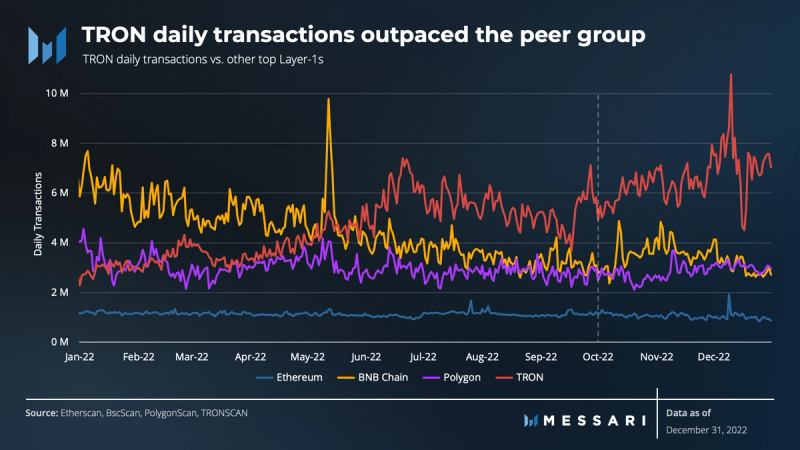
Daily transaction activity was up and to the right over the quarter. TRON finished the quarter with more daily transactions than the peer group, driven by the rush of TRX transfers and USDT contract interactions in December. The trend of TRX and USDT transactions was also the main driver of the upward trend throughout 2022.
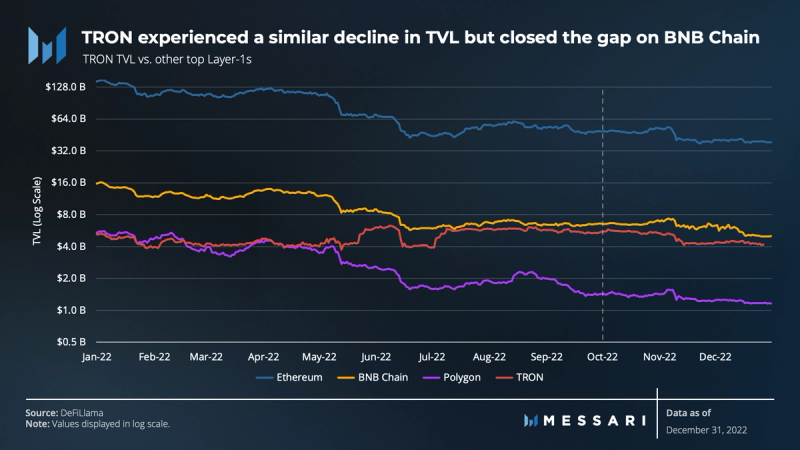
TRON’s TVL declined (23.7%) by a similar magnitude compared to the peer group. However, TRON closed the gap on BNB Chain, the second largest network by TVL behind Ethereum.

TRON gained stablecoin market share and remained the clear second to Ethereum regarding value on-chain. At the start and end of the quarter, Ethereum’s market share of stablecoin value was 66% compared to 34% on the other three chains. TRON began the quarter with 24% of the value and finished with 26%. The 2% increase suggests a slight squeeze on BNB Chain and Polygon’s 8% share of the stablecoin value.
Qualitative Analysis
Key Events, Catalysts, and Strategies for Ecosystem Growth

The TRON strategy continues to broaden. As mentioned, the protocol has expanded stablecoin adoption, changed network parameters such as the cost of Energy, and hosted events like the Grand Hackathon. Other aspects of the TRON strategy have been running in the background, which can be generalized into four key areas for Q4:
- Technical Developments — Improve network efficiency and functionality.
- User access and experience — Captivate users with greater user access and experience.
- Strategic Investment — Deploy financial capital to grow the ecosystem.
- Community — Acquire developers and drive adoption through community building.
Technical Developments
TRON continued to build onto the Great Voyage network during Q4. TRON client GreatVoyage-V4.6.0 (Socrates) was released in November. This mandatory release implemented upgrades from four TRON Improvement Proposals (TIP).
- TIP-387 – Applies a fee (also burned) for transactions with a memo. By increasing the cost, the fee reduces the number of low-value transactions.
- TIP-465 – A new staking reward algorithm used to reduce the time consumption of reward calculation.
- TIP-461 – Updated the checkpoint mechanism of data storage. The checkpoint is a recovery mechanism established to prevent database damage caused by an unforeseen network shutdown.
- TIP-476 – Optimizes the account index storage structure of resource delegation to improve transaction execution performance and throughput.
User Access and Experience
Access to the network and user experience improved with the full rollout of TronLink Wallet, TRON’s recommended wallet. During Q4, TronLink integrated with Android and iOS. It rolled out several features, including the ability to stake TRX for Energy and Bandwidth.
Further, ONTO Wallet, a decentralized digital identity (DID)-based gateway with over 1 million users, launched support for asset swaps on TRON.
While not related to direct access to the TRON network, the Binance CoinMarketCap Top 10 Equal-Weighted Index launched in Q4. The product is investable on Binance and includes TRX as one of the assets in the index. From an investment perspective, the index expands the reach of TRX.
Strategic Investment
In Q4, the $1 billion TRON DAO Ecosystem Fund launched TRON DAO Ventures (TDV) and added it to its list of existing investment pathways.
TDV was created to support start-up teams already working in the TRON ecosystem and established projects on other chains willing to bridge into the TRON ecosystem. TDV also joined the Binance Recovery Initiative, committing $50 million of TRX to aid projects exposed to the FTX plague.
Community
In addition to community engagement efforts by the Grand Hackathons held during 2022, another move to build community came with the announcement that TRON DAO was joining the Enterprise Ethereum Alliance.
While the Enterprise Ethereum Alliance aims to accelerate Ethereum advancements and adoption, TRON’s relationship with the Ethereum community and ability to invest with TDV could catalyze collaboration between the two networks.
Another initiative aimed at driving community engagement was the launch of TRON Academy. TRON Academy offers a comprehensive blockchain curriculum to educate developers and connect them to TRON development at an early stage. The program has been adopted by seven universities with blockchain clubs including Cornell, Princeton, and Dartmouth.
Ecosystem Challenges
Q4 did not present any material adverse outcomes from technical or ecosystem-specific challenges. However, the fallout of FTX reverberated through the TRON ecosystem, as was the case with many networks and ecosystems.
In response to the FTX incident, the TRON team announced that it reached an agreement between FTX and TRON DAO, Huobi, and Founder Justin Sun. They agreed to establish a “special facility” to allow TRX, BTT, JST, SUN, and HT holders to swap assets from the FTX exchange. This deal would address FTX’s liquidity crises by injecting capital into FTX in exchange for returning TRON user assets deposited on FTX. At the time of the announcement, FTX claimed that $13 million of assets would be deployed to facilitate the swaps.
While it was an applaudable effort on TRON’s side to protect its users, FTX was deemed insolvent and filed for bankruptcy shortly after the agreement and before many users could benefit from the deal.
The Road Ahead
TRON does not have a public-facing roadmap regarding its development. However, the team regularly makes announcements regarding plans. Much of the road ahead continues to reflect what the TRON ecosystem has been outwardly working on for several quarters.
TRON’s documentation suggests the ecosystem’s original 10-year roadmap has three key integrations on the horizon: Apollo, Star Trek, and Eternity. TRON continues to build onto the current Great Voyage network implementation and will eventually work towards the three implementations to continue to improve network functionality.
Beyond technical developments, TRON DAO and the community will continue to push ecosystem growth forward, with plans to further expand USDD. With the support of the TRON DAO Ecosystem Fund and all of its affiliated initiatives, investment in the ecosystem and community efforts should continue to bring on more developers, applications, and users.
Closing Summary
2022 was a tumultuous year for the crypto industry. Despite the resulting headwinds, the TRON network ushered in new users and network activity.
During Q4, daily active accounts on TRON consistently increased while daily activated (new) accounts experienced an unexpected surge to 1.3 million on December 10. Average daily transactions rose by 22.4% to 6.5 million, and smart contract execution and TRX transfers accounted for 90% of total transactions. Due to increased user activity, a substantial amount of TRX was burned instead of generated during the quarter.
None of the DeFi applications on TRON were immune to the macro climate of 2022 or the FTX fallout in Q4. The concentration of TVL in JustLend and stablecoin dominance in USDT remained unchanged. TRON remained a significant player in the stablecoin market, with its total market cap of stablecoins only second to Ethereum.
TRON client GreatVoyage-V4.6.0 (Socrates) was released to improve network functionality, with similar technical developments expected to continue.
Looking ahead, the TRON DAO Ecosystem Fund will aim to expand the use of USDD, diversify DeFi, and expand the TRON ecosystem into other sectors with the support of TRON DAO Ventures through 2023.

